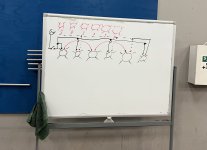LarryFine
Master Electrician Electric Contractor Richmond VA
- Location
- Henrico County, VA
- Occupation
- Electrical Contractor
Is the entire batch of lights to be switched as a single group? If so, the switching is easy.We have been tasked with completing a project utilizing 3-way and 4-way switches to lights utilizing both series and parallel circuits.
First switch is 4 way, second is 3 way and where power comes in, third is 4 way, fourth is 3way, 5 and 6 are 4way.
I need more clarification on how the lights should be connected together.
If he's asking for two answers, one with them in series and the other with them in parallel, also easy.
It's difficult to answer a question well without understanding the question well.


